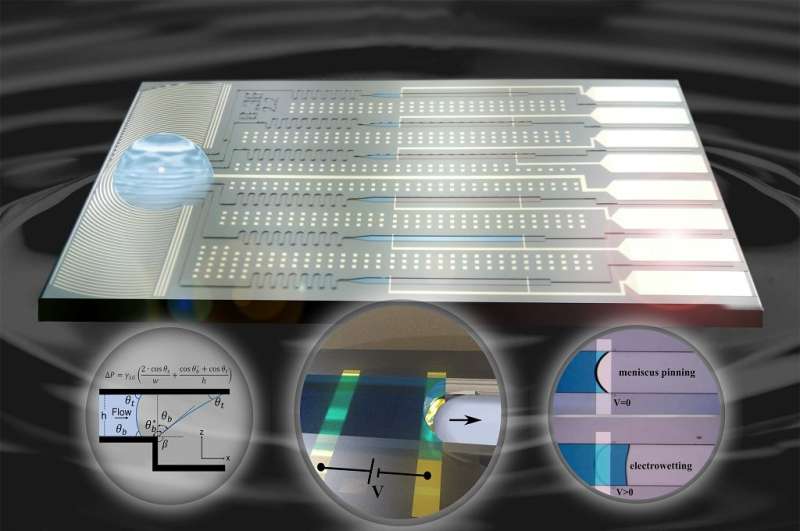April 24, 2018 feature
Electrogates offer stop-and-go control in microfluidics

Although microfluidics devices have a wide variety of uses, from point-of-care diagnostics to environmental analysis, one major limitation is that they cannot be modified for different uses on the fly, since their flow paths are set during fabrication. In a new study, researchers have addressed this limitation by designing electrogates that can regulate the flow of liquid at different points along the microchannel—a process that can be entirely controlled with a smartphone.
The researchers, Y. Arango, Y. Temiz, O. Gӧkçe, and E. Delamarche, at IBM Research-Zurich in Rüschlikon, Switzerland, have published a paper on electrogates in a recent issue of Applied Physics Letters.
"Point-of-care diagnostics represent a very segmented market," Delamarche told Phys.org. "For each type of test, a microfluidic device needs to be designed and fabricated to ensure optimal assay performances (volume of sample passing through the device, flow rates, time given for the reactions to take place, time given for dissolving some reagents in the chip with the sample, etc.). This is a bit frustrating, and with silicon microtechnology, it is always beneficial to cover as many applications as possible without too much redesign and changes in the manufacturing processes.
"This is where electrogates help, and this is what motivated us to invent them. The idea is to make chips much more generic and transfer some of the routing and timing of the flow to a software level, i.e., a protocol uploaded on a smartphone or tablet. Changing protocols on a software level is easy, fast, flexible and convenient."
Rather than using mechanical elements such as pumps and valves to control the flow, the electrogates are based on electrowetting. This process involves applying an electric voltage to control the wetting properties of the surface, which in turn controls the flow of the liquid.

Each electrogate consists of a trench etched into the bottom surface of the microchannel, with one electrode patterned over the trench and a second electrode patterned a short distance in front of the trench. When a liquid sample flows along the microchannel in the absence of a voltage, it stops at the trench because the abrupt change in the contact angle creates a pinning force on the liquid. A small voltage (<10 volts) applied between the two electrodes pulls down ions from the liquid to the edge of the trench where the liquid is pinned, which makes this area more wettable. As a consequence, the contact angle of the liquid in this area decreases, causing the liquid to resume flowing across the trench and through the microchannel.
The researchers demonstrated that the curvature of the trench determines the reliability and retention time of the electrogates. With a large curvature, they could achieve 100% reliability, start and stop times of less than a second, and retention times exceeding 5 minutes, which can be extended to beyond 45 minutes with additional strategies. The electrogates also work with various types of liquids, including human serum.
Among its advantages, the electrogates are easy to fabricate, have long-term stability, are biocompatible, and can be implemented in multiple locations on the same chip. The researchers expect that the electrogates can be easily implemented into low-power, portable microfluidics devices in the future.
"We are supported by a grant from the EU, and we still have a little bit of time to 'push' electrogates further," Delamarche said. "One task (nearly complete) is to vary the options for fabricating electrogates so that technologists have more freedom to design and fabricate them. This can help spread the concept, we think. Then, we will show specific examples where combining a few electrogates can create more advanced functions for microfluidic systems."
More information: Y. Arango, Y. Temiz, O. Gӧkçe, and E. Delamarche. "Electrogates for stop-and-go control of liquid flow in microfluidics." Applied Physics Letters. DOI: 10.1063/1.5019469
Journal information: Applied Physics Letters
© 2018 Phys.org





















